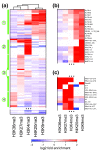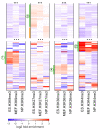Estimating enrichment of repetitive elements from high-throughput sequence data
- PMID: 20584328
- PMCID: PMC2911117
- DOI: 10.1186/gb-2010-11-6-r69
Estimating enrichment of repetitive elements from high-throughput sequence data
Abstract
We describe computational methods for analysis of repetitive elements from short-read sequencing data, and apply them to study histone modifications associated with the repetitive elements in human and mouse cells. Our results demonstrate that while accurate enrichment estimates can be obtained for individual repeat types and small sets of repeat instances, there are distinct combinatorial patterns of chromatin marks associated with major annotated repeat families, including H3K27me3/H3K9me3 differences among the endogenous retroviral element classes.
Figures





Similar articles
-
Widespread Chromatin Accessibility at Repetitive Elements Links Stem Cells with Human Cancer.Cell Rep. 2016 Nov 1;17(6):1607-1620. doi: 10.1016/j.celrep.2016.10.011. Cell Rep. 2016. PMID: 27806299 Free PMC article.
-
Investigating repetitively matching short sequencing reads: the enigmatic nature of H3K9me3.Epigenetics. 2009 Oct 1;4(7):476-86. doi: 10.4161/epi.4.7.9809. Epub 2009 Oct 14. Epigenetics. 2009. PMID: 19786836
-
Transcriptional repression of repeat-derived transcripts correlates with histone hypoacetylation at repetitive DNA elements in aged mice brain.Exp Gerontol. 2011 Oct;46(10):811-8. doi: 10.1016/j.exger.2011.07.001. Epub 2011 Jul 18. Exp Gerontol. 2011. PMID: 21782924
-
Repbase Update, a database of eukaryotic repetitive elements.Cytogenet Genome Res. 2005;110(1-4):462-7. doi: 10.1159/000084979. Cytogenet Genome Res. 2005. PMID: 16093699 Review.
-
Deciphering Neurodegenerative Diseases Using Long-Read Sequencing.Neurology. 2021 Aug 31;97(9):423-433. doi: 10.1212/WNL.0000000000012466. Epub 2021 Aug 13. Neurology. 2021. PMID: 34389649 Free PMC article. Review.
Cited by
-
Transposable elements are regulated by context-specific patterns of chromatin marks in mouse embryonic stem cells.Nat Commun. 2019 Jan 3;10(1):34. doi: 10.1038/s41467-018-08006-y. Nat Commun. 2019. PMID: 30604769 Free PMC article.
-
Differential enrichment of H3K9me3 at annotated satellite DNA repeats in human cell lines and during fetal development in mouse.Epigenetics Chromatin. 2021 Oct 18;14(1):47. doi: 10.1186/s13072-021-00423-6. Epigenetics Chromatin. 2021. PMID: 34663449 Free PMC article.
-
New players in heterochromatin silencing: histone variant H3.3 and the ATRX/DAXX chaperone.Nucleic Acids Res. 2016 Feb 29;44(4):1496-501. doi: 10.1093/nar/gkw012. Epub 2016 Jan 14. Nucleic Acids Res. 2016. PMID: 26773061 Free PMC article. Review.
-
PML protein organizes heterochromatin domains where it regulates histone H3.3 deposition by ATRX/DAXX.Genome Res. 2017 Jun;27(6):913-921. doi: 10.1101/gr.215830.116. Epub 2017 Mar 24. Genome Res. 2017. PMID: 28341773 Free PMC article.
-
Identifying and mitigating bias in next-generation sequencing methods for chromatin biology.Nat Rev Genet. 2014 Nov;15(11):709-21. doi: 10.1038/nrg3788. Epub 2014 Sep 16. Nat Rev Genet. 2014. PMID: 25223782 Free PMC article. Review.
References
-
- Chen X, Xu H, Yuan P, Fang F, Huss M, Vega VB, Wong E, Orlov YL, Zhang W, Jiang J, Loh YH, Yeo HC, Yeo ZX, Narang V, Govindarajan KR, Leong B, Shahab A, Ruan Y, Bourque G, Sung WK, Clarke ND, Wei CL, Ng HH. Integration of external signaling pathways with the core transcriptional network in embryonic stem cells. Cell. 2008;133:1106–1117. doi: 10.1016/j.cell.2008.04.043. - DOI - PubMed
-
- Mikkelsen TS, Ku M, Jaffe DB, Issac B, Lieberman E, Giannoukos G, Alvarez P, Brockman W, Kim TK, Koche RP, Lee W, Mendenhall E, O'Donovan A, Presser A, Russ C, Xie X, Meissner A, Wernig M, Jaenisch R, Nusbaum C, Lander ES, Bernstein BE. Genome-wide maps of chromatin state in pluripotent and lineage-committed cells. Nature. 2007;448:553–560. doi: 10.1038/nature06008. - DOI - PMC - PubMed
-
- Birney E, Stamatoyannopoulos JA, Dutta A, Guigo R, Gingeras TR, Margulies EH, Weng Z, Snyder M, Dermitzakis ET, Thurman RE, Kuehn MS, Taylor CM, Neph S, Koch CM, Asthana S, Malhotra A, Adzhubei I, Greenbaum JA, Andrews RM, Flicek P, Boyle PJ, Cao H, Carter NP, Clelland GK, Davis S, Day N, Dhami P, Dillon SC, Dorschner MO, Fiegler H. Identification and analysis of functional elements in 1% of the human genome by the ENCODE pilot project. Nature. 2007;447:799–816. doi: 10.1038/nature05874. - DOI - PMC - PubMed
MeSH terms
Substances
LinkOut - more resources
Full Text Sources
Other Literature Sources

